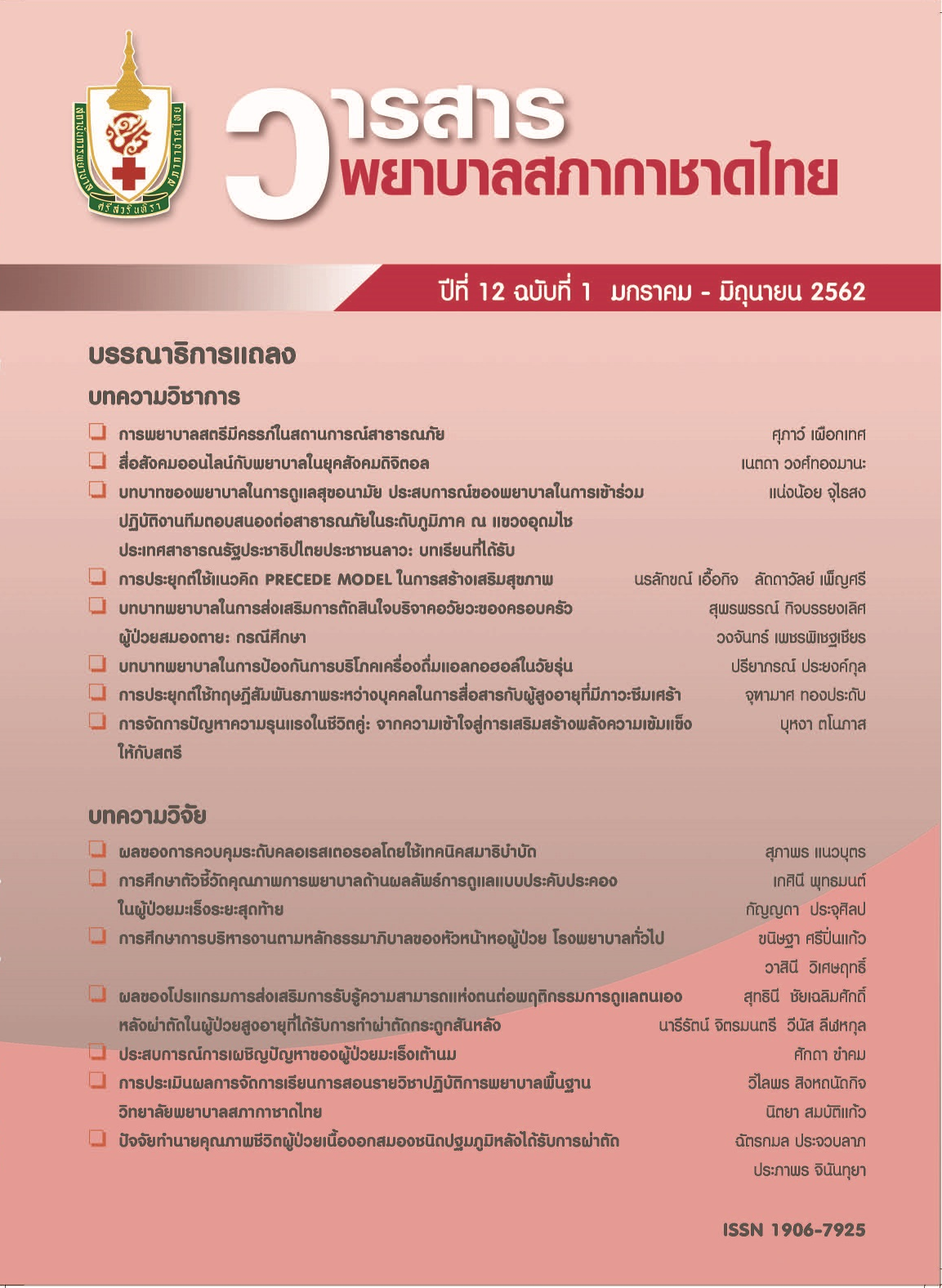Nursing Care for Pregnant Women During a Disaster
Keywords:
pregnant woman, disaster, nursing careAbstract
During disaster situations, pregnant women are among the most vulnerable groups that need special care. Disasters can adversely affect the physical and mental health of pregnant women, including preterm labor and intrauterine growth retardation, particularly when they have to evacuate to a public shelter. Thus, nurses should provide appropriate health care for disaster-affected pregnant women, including preparing nutritious food for health promotion, preparing proper sheltering, and providing counseling services to relieve stress. Moreover, the nurse should play a role in disaster preparedness for pregnant women in all disaster phases: pre-impact, impact and post-impact.
References
2. Rungreangkulkij S, Kotnara I. Integrated gender in disaster management for Nurses. Songklanagarind Journal of Nursing 2013;33(1):57-67. (in Thai)
3. World Health Organization. Risk reduction and emergency preparedness [Internet]. 2007 [cited 2017 Jul 18]. Available from: https://www.who.int/hac/techguidance/ preparedness/emergency_preparedness_eng.pdf
4. International Federation of Red Cross and Red Crescent Societies. Introduction to Disaster Preparedness [Internet]. 2000 [cited 2017 Jul 18]. Available from: https://www.ifrc.org/Global/Introdp.pdf
5. Department of Disaster Prevention and Mitigation. Ministry of Interior. Disaster Prevention and Mitigation Act, B.E. 2550 (2007). [Internet]. (n.d.) [cited 2017 Jul 20]; Available from: https://www.thailaws.com/law/t_laws/tlaw0397.pdf
6. Chawanpaiboon S. Preterm labour. Bangkok: P. A. Living; 2010. (in Thai)
7. Katumarn P. Post-Traumatic Stress Disorder [Internet]. 2017 [cited 2017 Jul 20]. Available from: https://www.psyclin.co.th/new_page_62.htm.
8. Rogal SS, Poschman K, Belanger K, Howell HB, Smith MV, Medina J, et al. Effects of posttraumatic stress disorder on pregnancy outcomes. J Affect Disord 2007;102(1-3):137-43.
9. Ohlsson A, Shan PS. Effects of the September 11, 2001 disaster on pregnancy outcomes: a systematic review. Acta Obstet Gynecol Scand 2011;90(1):6-18.
10. Ng TP, Foo SC, Yoong T. Risk of spontaneous abortion in workers exposed to toluene. Br J Ind Med 1992;49(11):804-8.
11. Vejaratpimol R. Toluene : Risk for abortion and fetal abnormalities [Internet]. 2009 [cited 2017 Jul 2]; Available from: https://greenworld.or.th/wp-content/uploads/2016/12/toluene.pdf
12. International Council of Nurses. ICN framework of disaster nursing competencies [Internet]. 2009 [cited 2017 Jul 23]; Available from: https://www.icn.ch/images/stories/documents/networks/DisasterPreparednessNetwork/Disaster_Nursing_Competencies_lite.pdf
13. Krongthaeo S, Piaseu N. Concept and Nurse’s Role for Disaster Preparedness. Rama Nurs J 2015;21(2):141-57. (in Thai)
14. Johnson R, Taylor W. Skills for Midwifery Practice. (4th ed.). Edinburgh: Elsevier; 2016.
15. Inkaew W, Chompunuch S. Disaster Nursing. Bangkok: Beyond Publishing; 2014. (in Thai)
16. Charoenvit T. Fetal assessment. In: Worasetsin P, Poolcharoen N, editors. OB & GYN Update & Practical XVI. Bangkok: Concept medical; 2017. p.147-70. (in Thai)
17. Seeherunwong A, Yuttatri P. Psychological care for disaster survivors. Thai Journal of Nursing Council 2007;22(4):10-23. (in Thai)
Downloads
Published
Issue
Section
License
เนื้อหาบทความหรือข้อคิดเห็นต่างๆ ในวารสารพยาบาลสภากาชาดไทยนี้ เป็นความคิดเห็นของผู้เขียนบทความ ไม่ใช่ความเห็นของกองบรรณาธิการ หรือสถาบันการพยาบาลศรีสวรินทิรา สภากาชาดไทย






